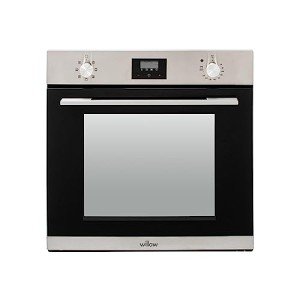Guide To Builtin Ovens: The Intermediate Guide In Builtin Ovens
페이지 정보
작성자 Duane 댓글 0건 조회 14회 작성일 25-05-18 03:18본문
The Rise of Built-in Ovens: Enhancing Modern Kitchens
In the ever-evolving world of home enhancement, built-in ovens have actually emerged as a staple in contemporary kitchen design. These appliances not only offer a sleek and seamless aesthetic but also contribute considerably to the functionality and effectiveness of home cooking. This short article delves into the numerous aspects of built-in ovens, including their benefits, types, installation factors to consider, and upkeep, in addition to regularly asked concerns to supply a thorough introduction.
What is a Built-in Oven?
A built-in oven is an appliance created to be set up into kitchen cabinets, giving it a streamlined look and freeing up counter area. Unlike traditional freestanding ovens, which stand alone and are frequently bulky, built-in ovens fit flush with kitchen cabinetry for a more integrated appearance. They are offered in various sizes, styles, and features, dealing with a wide variety of culinary requirements and kitchen designs.
Benefits of Built-in Ovens
Built-in ovens come with many advantages that make them attractive to house owners. Below are some of the key advantages:
- Space Efficiency: Built-in ovens save counter area while optimizing kitchen layouts.
- Adjustable Design: They can be integrated into cabinetry, allowing property owners to tailor looks according to individual taste.
- Boosted Performance: Many built-in ovens come equipped with sophisticated cooking innovations, permitting better heat distribution and faster cooking times.
- Ease of access: Their installation at eye level makes it much easier to inspect food without flexing down, providing higher convenience and security.
- Resale Value: A modern, properly designed kitchen can enhance residential or commercial property value, making built in ovens for sale-in fitted ovens an investment worth thinking about.
Types of Built-in Ovens
Built-in ovens can be categorized based upon their design and function. The following list details the typical kinds of built-in ovens available on the marketplace:
- Single Ovens: A standard model that includes one cooking compartment.
- Double Ovens: These included two different compartments, Build in oven which enable cooking numerous meals at various temperatures.
- Wall Ovens: Installed into the wall for a space-saving solution, these ovens provide convenience and availability and can be either single or double.
- Steam Ovens: These make use of steam for damp cooking and are frequently preferred for much healthier meal preparation.
- Convection Ovens: Designed with a fan that distributes hot air, ensuring even cooking and browning.
| Type | Description | Ideal For |
|---|---|---|
| Single Oven | One cooking compartment for basic baking and roasting. | Little households and cooking areas. |
| Double Oven | 2 compartments for synchronised cooking of various dishes. | Large families with diverse menus. |
| Wall inbuilt oven | Built into the wall for simple gain access to. | Space-conscious cooking areas. |
| Steam Oven | Cooks using steam for much healthier options. | Health-conscious individuals. |
| Stove | Circulates hot air for even cooking and quicker outcomes. | Baking enthusiasts and chefs. |
Installation Considerations
Selecting to set up a built-in oven involves several considerations to guarantee that it fits seamlessly within the kitchen. Essential aspects include:
- Cabinet Dimensions: Accurate measurement of the cabinet area needed for the oven is important for a proper fit.
- Power Supply: Built-in builtin ovens (visit the following page) generally need a dedicated power supply; seeking advice from a certified electrical expert might be essential.
- Ventilation: Ensure that the oven's ventilation requirements are satisfied to promote safe operation.
- Local Building Codes: Compliance with local codes is essential when installing any kitchen device.
It's strongly advised that setup be carried out by specialists to make sure safety and adherence to producer specifications.
Upkeep of Built-in Ovens
Preserving built-in ovens is vital to guarantee their longevity and operation. Below are some ideas for reliable maintenance:
- Regular Cleaning: Wipe down surfaces after each use to prevent build-up; consider self-cleaning alternatives if readily available.
- Examine Seals: Inspect the oven door seals regularly for wear and tear to keep efficiency and avoid heat loss.
- Adjust Temperature: Occasionally check and adjust oven temperature level settings if cooking outcomes are irregular.
- Professional Servicing: Schedule routine upkeep with qualified specialists for electrical components and much deeper cleansing.
Regularly Asked Questions (FAQs)
Q1: How do I choose the ideal size built-in oven for my kitchen?
A1: Measure the available cabinet area and consider the cooking habits of your family. Single or double ovens prevail choices based upon meal preparation requirements.
Q2: Are built-in ovens more energy-efficient than freestanding ones?
A2: Built-in ovens can be more energy-efficient due to much better insulation and advanced cooking innovation; nevertheless, actual efficiency depends upon the specific model and usage.
Q3: Can built-in ovens be installed throughout the kitchen?
A3: Built-in ovens need specific kitchen cabinetry and might require a dedicated source of power, Builtin oven so preparing their placement thoroughly within the kitchen layout is necessary.

Q4: What sort of maintenance do built-in ovens require?
A4: Regular cleaning, examining door seals, calibrating temperature levels, and professional servicing as needed are all parts of correct upkeep.
Built-in ovens are an impressive addition to modern kitchens, offering both aesthetic and useful benefits. Their space-saving design, customizable choices, and advanced functions deal with varied cooking requirements. When considering a built-in oven, homeowners need to take into consideration their particular culinary choices, kitchen design, and upkeep capabilities. By doing so, they would be making an important financial investment in their home, increasing both performance and style.
댓글목록
등록된 댓글이 없습니다.